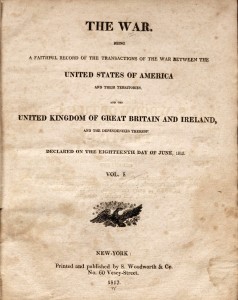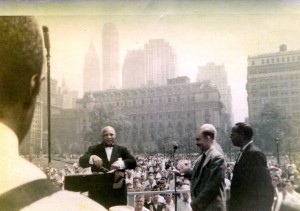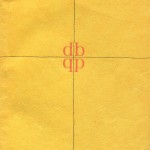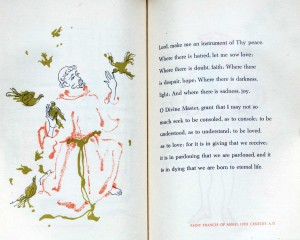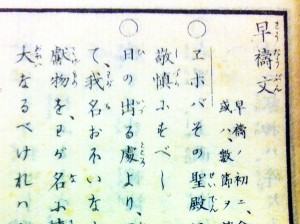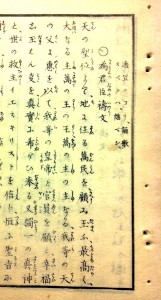[Posted by Professor Sarah Rivett, Princeton University]
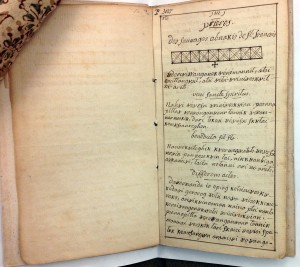 Housed in the American Indian Vocabulary Collection of the Watkinson Library are two manuscript prayer books from the eighteenth century, written in the Abenaki language. The prayer books are in the same hand, and on the inside of the front cover of one of them, we have a clue as to who the author might have been: “Father Germain, the last Jesuit missionary of the St. Francis.” Ordained in Belgium, Charles Germain decided to work as a missionary in New France. He lived among the Abenaki for twenty-nine years, from 1739 until his death in 1779.
Housed in the American Indian Vocabulary Collection of the Watkinson Library are two manuscript prayer books from the eighteenth century, written in the Abenaki language. The prayer books are in the same hand, and on the inside of the front cover of one of them, we have a clue as to who the author might have been: “Father Germain, the last Jesuit missionary of the St. Francis.” Ordained in Belgium, Charles Germain decided to work as a missionary in New France. He lived among the Abenaki for twenty-nine years, from 1739 until his death in 1779.
Germain lived through tumultuous times of a war-ravaged northeast that culminated with British dominion of North America following the Seven Years War (1754 – 1763). When Germain arrived in the Abenaki community in Acadia, the region was already under British control, as a consequence of the Treaty of Paris (1713) that ended the War of Spanish Succession. Germain was a military strategist as well as a missionary. He worked as a liaison between the government of New France and the Abenaki Indians under his pastoral care. His aim, like that of his predecessor, Sebastian Rale, was to consolidate Acadian resistance by ensuring that Franco-Catholicism left a lasting mark on North America. Committed to his faith and his country of origin, Germain’s proselytizing of Abenaki souls was intimately connected to his disdain for the Anglo-Protestantism.
Language was Germain’s tool of both Abenaki conversion and war strategy. Speaking the language of the indigenous inhabitants of North America proficiently was the best means of communicating Christian doctrine and establishing alliances. Since the French presence in North American paled in comparison to the British, in terms of population and cosmopolitan development, the Indian-French alliance was France’s only hope of survival. Luckily for Germain, his Jesuit predecessors were accomplished linguists. Sebastian Rale lived among the Abenaki in Norridgewalk from 1691 until his death at the hands of the British in 1722. He composed an extensive dictionary that is now housed at the Houghton Library in Cambridge Massachusetts. For Rale, learning Abenaki was an incredibly difficult task. There were no books on the topic, no grammars, and no teachers other than the Abenaki themselves. Rale describes going to sit in Abenaki wigwams for eight to nine hours every day as “a child goes to school.” He spoke as best he could and the Abenaki corrected him. Because of Rale’s work, Father Germain entered a community with a fairly substantial written record of Abenaki. Indeed, we might even speculate that Germain developed his prayer books from Rale’s scribal publications of similar texts. Additionally, some of the Abenaki would have known French while others were used to playing the role of teacher to the Jesuit missionaries in an ironic process of role reversal where the European became the student and the American Indian the teacher.
 Scale is the most striking material difference between the Abenaki Prayer Books composed by Germain and Rale’s Abenaki Dictionary, or the monumental Illinois-French Dictionary compiled by Jacques Gravier and also housed at the Watkinson Library. Gravier’s dictionary contains over twenty-two thousand words listed alphabetically, with the Illinois preceding the French. The writing is small, economizing space in the enormous tome bound in marbled leather. Composed over decades, words were crossed out. Corrections were made, sometimes in Gravier’s hand and sometimes in a different hand, possibly that of his successors, Julien Binneteau and Gabriel Marest. By contrast, the Abenaki prayer books are small enough to fit in a missionary’s pocket. Composed of only about twenty leaves, they are sewn together with a thin piece of leather. The design ensures that the books function as useable texts in liturgical and ritual worship. The contents are equally succinct: morning prayers, evening prayers, the Ave Maria, the ten commandments, catechisms, confessional prayers, and psalms. Each title appears in French, as a clue to the priest leading the service, while the text itself is in Abenaki. It is likely that these prayer books were used by priests other than Germain. Such was the case with the Illinois prayer book written by Claude Allouez for Father Jacques Marquette to take on his travels along the Joliet trail. With the aid of such a prayer book, a priest could get by with minimal language skills. The prayers were mnemonic, sung within the context of a primarily oral indigenous language culture. Additionally, many of the Abenaki who had already converted to Catholicism lead the prayers during ritual worship, often more effectively than the priests who were bound by a partial understanding of both the language and the worldview that it represented.
Scale is the most striking material difference between the Abenaki Prayer Books composed by Germain and Rale’s Abenaki Dictionary, or the monumental Illinois-French Dictionary compiled by Jacques Gravier and also housed at the Watkinson Library. Gravier’s dictionary contains over twenty-two thousand words listed alphabetically, with the Illinois preceding the French. The writing is small, economizing space in the enormous tome bound in marbled leather. Composed over decades, words were crossed out. Corrections were made, sometimes in Gravier’s hand and sometimes in a different hand, possibly that of his successors, Julien Binneteau and Gabriel Marest. By contrast, the Abenaki prayer books are small enough to fit in a missionary’s pocket. Composed of only about twenty leaves, they are sewn together with a thin piece of leather. The design ensures that the books function as useable texts in liturgical and ritual worship. The contents are equally succinct: morning prayers, evening prayers, the Ave Maria, the ten commandments, catechisms, confessional prayers, and psalms. Each title appears in French, as a clue to the priest leading the service, while the text itself is in Abenaki. It is likely that these prayer books were used by priests other than Germain. Such was the case with the Illinois prayer book written by Claude Allouez for Father Jacques Marquette to take on his travels along the Joliet trail. With the aid of such a prayer book, a priest could get by with minimal language skills. The prayers were mnemonic, sung within the context of a primarily oral indigenous language culture. Additionally, many of the Abenaki who had already converted to Catholicism lead the prayers during ritual worship, often more effectively than the priests who were bound by a partial understanding of both the language and the worldview that it represented.
Germain entered into Abenaki territory with the goal of controlling the Abenaki people for imperial purposes. The Abenaki-French alliance during the Seven Years War is the dominant narrative that we associate with this time period. Yet texts such as these Abenaki prayer books suggest an alternative perspective, one in which language both facilitated French desire for indigenous dominance and undermined it. To learn the language, missionaries had to submit to instruction. They had to suspend their education and their linguistic training in Latin, Greek, and Hebrew in addition to several European languages. The indigenous languages of North America were nothing like they had ever encountered, nothing that they could have planned for upon leaving the Old World. To become proficient in Abenaki, Rale would assemble a group of native speakers whom he felt to be the most intelligent and eloquent. Before them, he would recite the catechism and hear their corrections. In doing so, he learned how different the language was from European languages, how delicate the mode of correct expression was. The massive dictionaries produced by Jesuit missionaries at the turn of the eighteenth century were attempts to visually capture the phonetic sounds of the spoken words around them. The catechism functioned as an educational text for native proselytes and missionaries alike. In some cases, this is all we have left of an otherwise lost language.
As anyone who has studied a language other than his or her own mother tongue knows, language is a window into a worldview. Language gives us unique access to another culture. Something is always lost through translation, but in the case of the Abenaki prayer books, something was also gained. These texts became mnemonic tools for priests and proselytes alike. The form of translation reflected in the prayer books was cyclical, from oral to written and then back to oral. In learning the Abenaki language, the Jesuits also learned of Abenaki culture. And while Christianity was a tool of colonization, it also changed through translation. Doctrine, pious practice, and religious expression took on new resonance when expressed through words intended to represent an entirely different cosmos.



